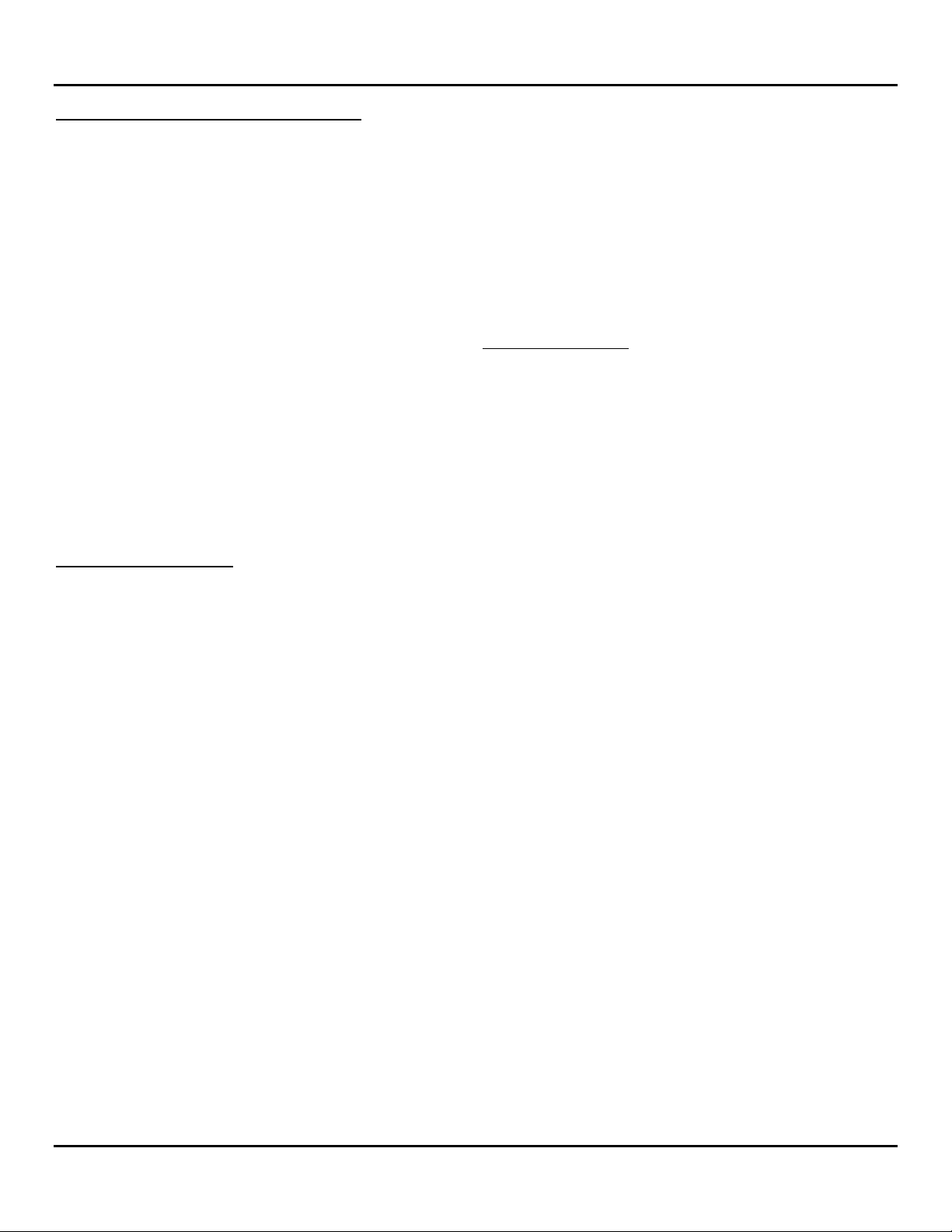
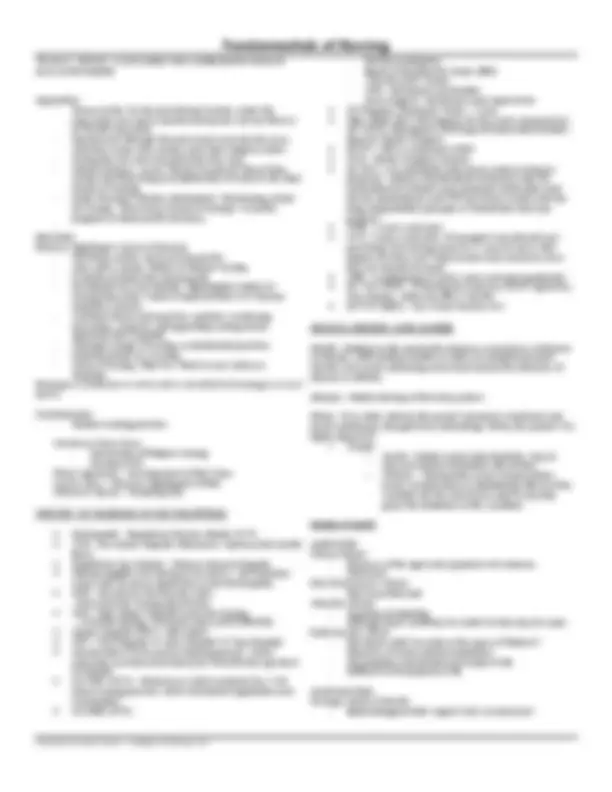

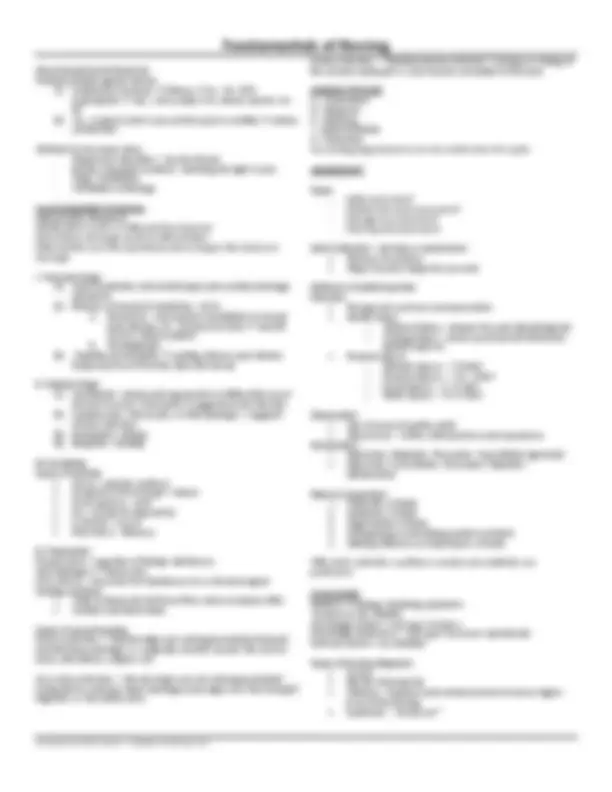
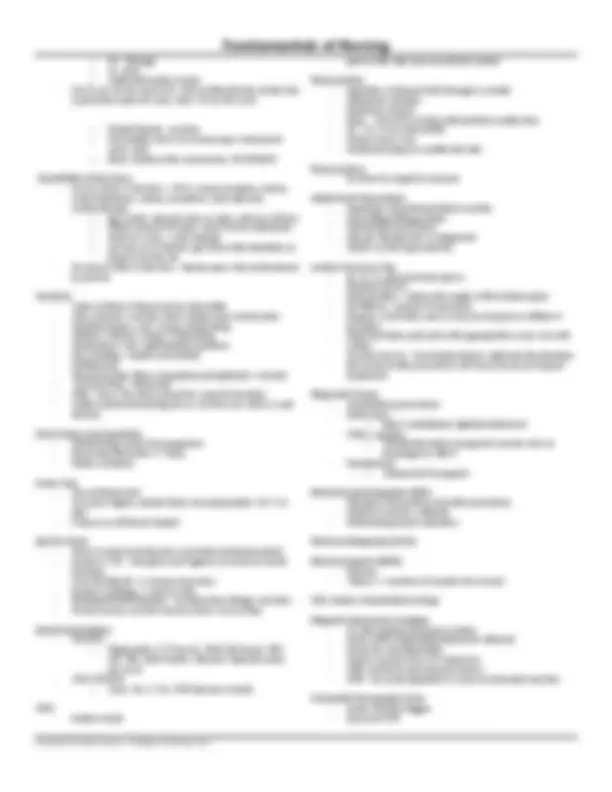
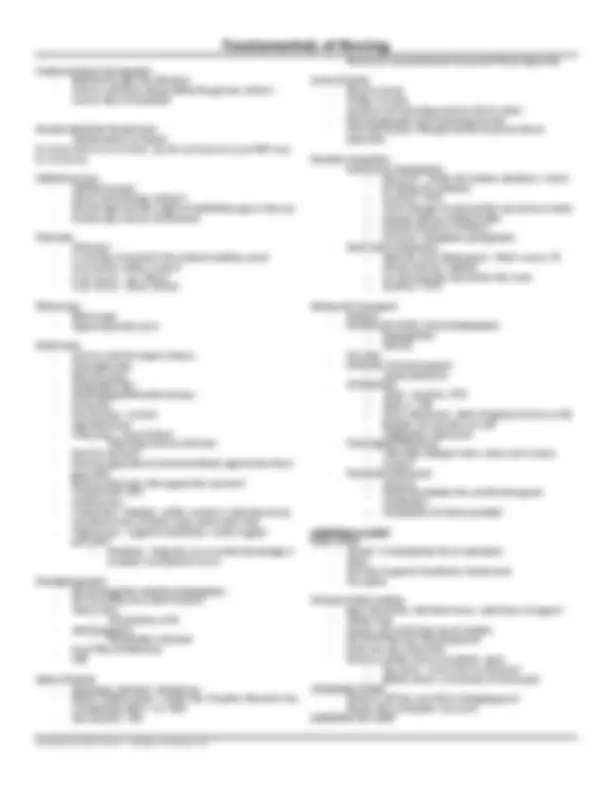
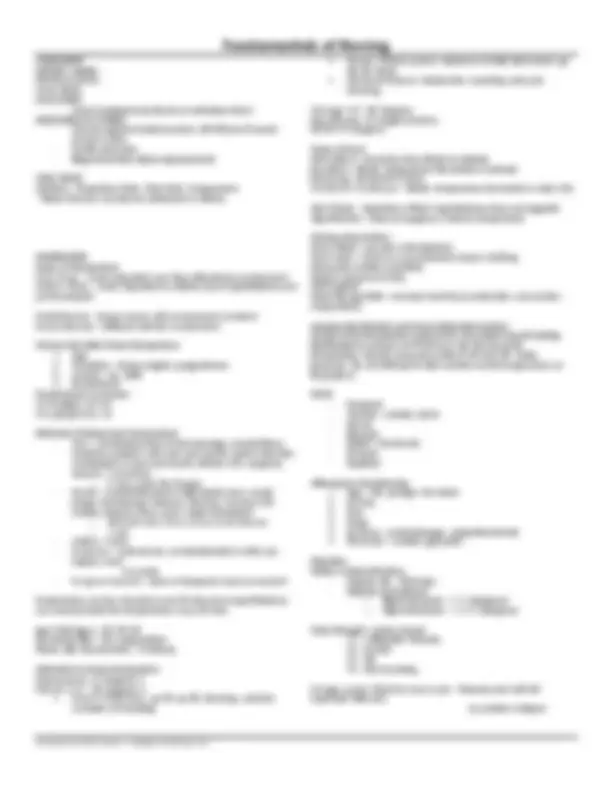
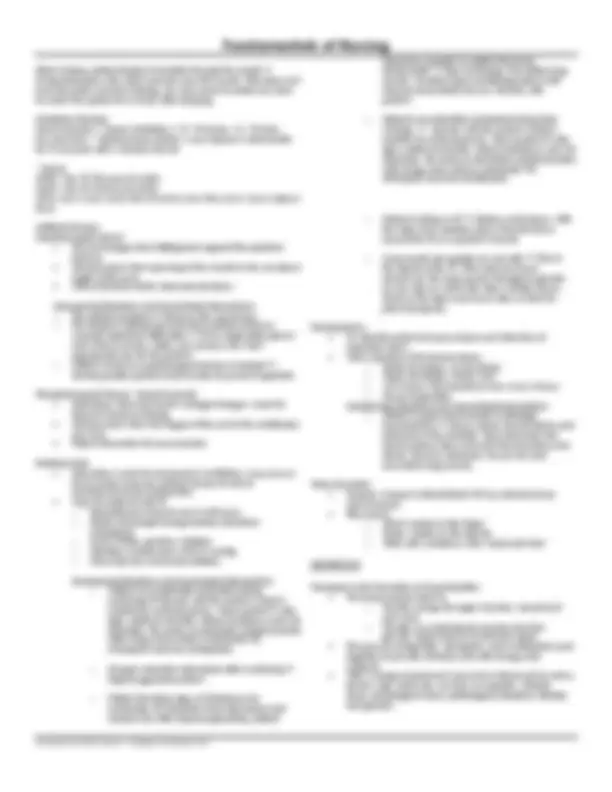
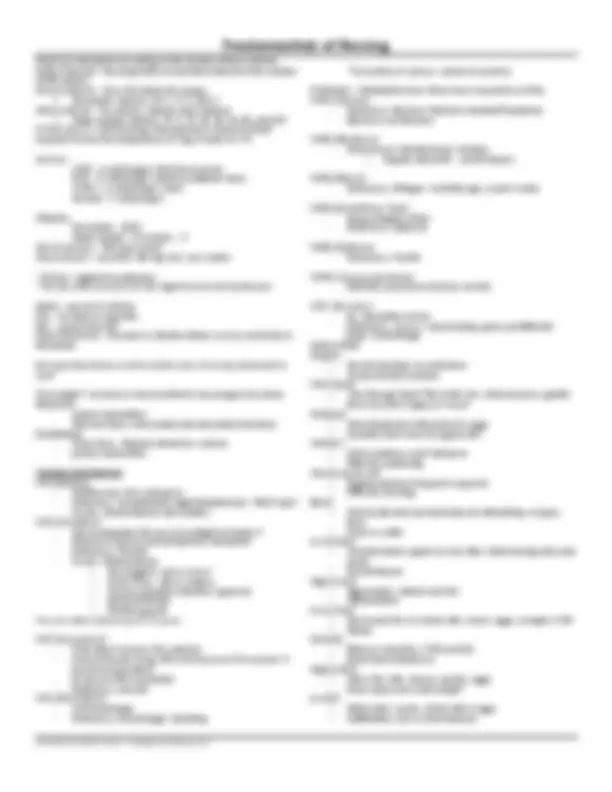
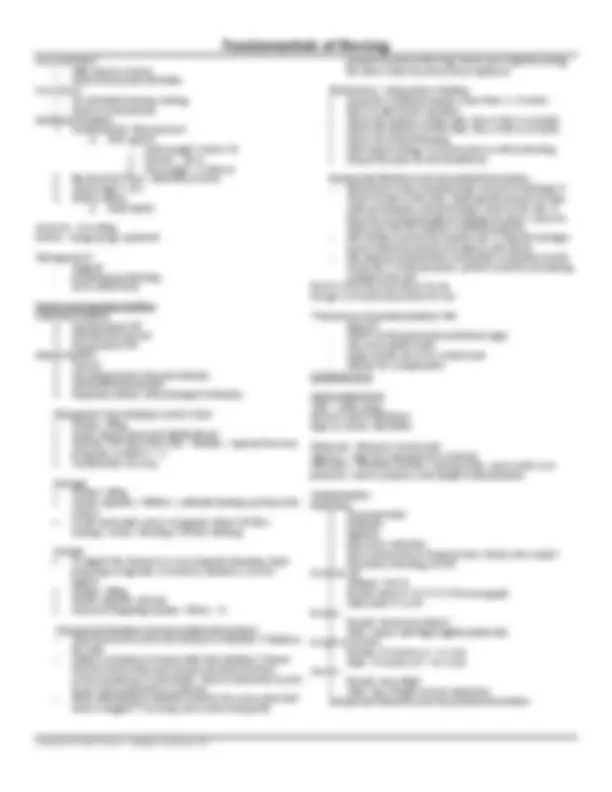
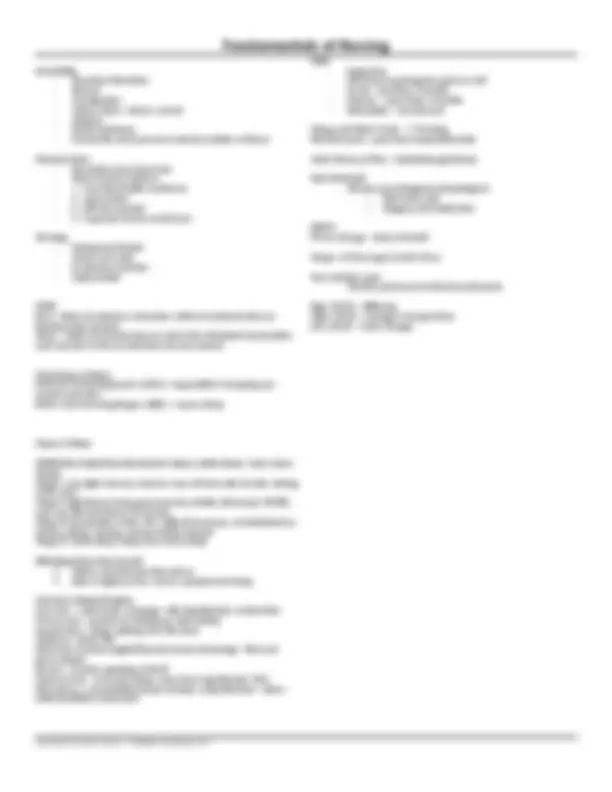


Study with the several resources on Docsity

Earn points by helping other students or get them with a premium plan


Prepare for your exams
Study with the several resources on Docsity

Earn points to download
Earn points by helping other students or get them with a premium plan
Community
Ask the community for help and clear up your study doubts
Discover the best universities in your country according to Docsity users
Free resources
Download our free guides on studying techniques, anxiety management strategies, and thesis advice from Docsity tutors
fundamentals of nursing reviewer notes
Typology: Lecture notes
1 / 18

This page cannot be seen from the preview
Don't miss anything!











Theory – set of concepts to explain a phenomenon Paradigm – pattern
4 Metaparadigms of Nursing Person - Most important because knowing the client will make your nursing care individualized, holistic, ethical, and humane. Health Environment Nursing
Concepts of Man Man is a bio-psychosocial and spiritual being who is in constant contact with the environment. Man is an open system in constant interaction with a changing environment. Man is a unified whole composed of parts, which are interdependent and interrelated with each other. Man is composed of parts, which are greater than and different from the sum of all his parts. o Simply saying, you cannot remove 1 system from man. Man is composed of subsystems and suprasystems. o Subsystem (within) Example: biological, psychological, emotional.
community, population
Florence Nightingale Act of utilizing the environment of the patient to assist him in his recovery.
Sister Callista Roy Theoretical system of knowledge that prescribes a process of analysis and action related to the care of the ill person.
Martha Rogers Nursing is a humanistic science dedicated to the compassionate concern with maintaining and promoting health and preventing illness and caring for and rehabilitating the sick and disabled. o Levels of prevention Primary – Health promotion and disease prevention Secondary – Treatment, curative Tertiary – Rehabilitation
Dorothea Orem (Self-care and Self-care deficit theory) Helping or assisting service to persons who are wholly or partly dependent, when they, their parents and guardians, or other adults responsible for their care are no longer able to give or supervise their care. o I.e. – completely assisted, partially assisted, and self-assisted.
ANA (American Nurses Association) Nursing is the protection, promotion, and optimization of health and abilities, prevention of illness and injury, alleviation of suffering through the diagnosis and advocacy in the care of individuals, families, communities, and populations (2003).
Abraham Maslow’s Hierarchy of needs Self-actualization
Self-esteem Love and belongingness
Safety and Security o Being free from harm or danger o 2 forms: Physical safety (free from physical harm) and Psychological safety (explaining the procedure to the patient) Physiologic (priority) o If all the needs are within the physiologic level High Priority needs – (life threatening needs) Airway, Breathing, Circulation Medium priority needs – (Health threatening needs) Elimination, Nutrition, Comfort, Low Priority needs – (Person’s developmental needs)
Florence Nightingale Environment Theory May 12, 1830 – August 13, 1910 Environmental sanitation
Hildegard Peplau Psychodynamic Theory of Nursing Interpersonal Process Phases of Nurse-patient relationship:
Virginia Henderson 14 Fundamental needs of the person
Faye Abdellah Typology of 21 Nursing problems Patient-centered approach o The client’s needs are the basis of the nursing problems Lydia Hall 3 C’s:
Jean Watson Human Caring Theory Caring is an innate characteristic of every nurse. 10 Carative factors
Ida Jean Orlando-Pelletier Dynamic Nurse-Patient Relationship Model Nursing Process Theory o Nursing as a process involved in interacting with an ill individual to meet an immediate need. Four Practices Basic to Nursing o Observation, reporting, recording, and actions
Madeleine Leininger Transcultural Theory of Nursing
Myra Levine 4 Principles of Conservation
Sister Callista Roy Adaptation Model Individuals cope through biophysical social adaptation 4 mode of adaptation o Role function, interdependence, physiological, self-concept
Dorothea Orem Self-care and Self-care Deficit Theory Universal self-care requirement (nutrition, oxygenation), developmental self-care requirement (developmental tasks), health care deviation self-care requirement 3 Nursing systems: wholly compensatory ,partially compensatory, supportive-educative compensatory
Dorothy Johnson Behavioral Systems Theory Man is composed of subsystems and these systems exist in dynamic stability.
Martha Rogers Science of Unitary Human Being Unitary man is an energy field in constant interaction with the environment.
Imogene King Goal Attainment Theory Interacting systems framework Nurses purposefully interact with the patient and mutually set the goal, explore, and agree to means to achieve the goals.
Betty Neuman Total Person Model 3 types of stressors: intra-personal, extra personal, interpersonal Primary, secondary, tertiary levels of prevention The goal of nursing is to assist individual families and groups in attaining and maintaining a maximal level of total wellness by purposeful interventions.
Parse Theory of Human Becoming emphasizes how individual chose and bear responsibility for patterns of personal health
Patricia Benner Novice – Expert Theory Stage 1: Novice Stage 2: Advance beginner Stage 3: Competent (2-3 years) Stage 4: Proficient (3-5 years) Stage 5: Expert Skills acquisition
Joyce Travelbee Human to Human Relationship
Ernestein Weidenbach Clinical Nursing: A Helping Art
Nola Pender Health Promotion Model
Carmencita Abaquin Chairman of Board of Nursing PREPARE ME intervention P – presence which in RE – reminisce therapy P - prayer Re - relaxation ME – medication
Sr. Caroline Agravante The CASAGRA Transformative Leadership model 5 C’s for Transformational leadership: creative, caring, critical, contemplative, collegial
Carmelita Divinagracia COM POSURE Behavior for wellness COM petence P resence of Prayer, O pen mindedness, S timulation, U nderstanding, R espect, R elaxation, E mpathy
Mila Delia Llanes Conceptual model on Core Competency Development
Ma. Irma Bustamante
Sr. Letty Kuan
St. Elizabeth of Hungary - Patroness of nurses St. Catherine of Siena – The 1st^ lady with the lamp Clara Barton – Founder of American Red Cross Fabiola – Wealthy Matron who donated her wealth to build a hospital the Christian world T. Fliedner – Founder of the first organized school of nursing Rose Nicolet – Helped establish the first school of nursing in the Philippines Lilian Wald – Founder of Public Health Nursing
Intuitive
Multiple Causation Theory of Disease
Travis’ Illness-Wellness Continuum
Dunn’s High Level Wellness Grid
Schumann’s Stages of Illness Behaviors
Opposite of health is illness, not disease
STRESS Organisms reacts as a unified whole Fabric of life
Models of Stress Response Based Model (Selye)
Transaction-based Model
Stimulus Based Model
Adaptation Model
CRISIS
Eustress – helpful stress
Distress – harmful to health Body adapts to the changes in the environment which leads to Homeostasis (Walter B. Cannon) Cloud Bernard – called homeostasis as “therapeutic milieu”
Adaptation - change to maintain integrity of the environment
Models of Adaptation Biological/Physiological – GAS and LAS; compensatory physical changes Emotional/Psychological – involves a change in attitudes or behavior Socio-cultural – changes in the person’s behavior in accordance with norms, conventions and beliefs of various groups. Technological – involves the use of modern technology
Principles of Homeostatic Mechanisms
STRESS RESPONSE Lazarus’ Stress Response Theory General Adaptation Syndrome (GAS) – a physiological response is a systemic response Local Adaptation Syndrome (LAS) - Only a part of the body
General Adaptation Syndrome Stages Alarm
General Adaptation Response Sympathoadreno-medullary Response (SAMR)
Adrenocortical Response Anterior pituitary gland Adreno corticotropic hormone adrenal cortex (1) release of aldosterone kidneys increase Na reabsorption (2) release of cortisol fats & CHON catabolism glucose
Neurohypophyseal Response Posterior pituitary gland release (1) Antidiuretic hormone kidneys inc. Na, H2O reabsorption dec. urine output, inc. blood volume, inc. BP (2) Inc. oxytocin ( aids in ejaculation/sperm motility ) uterine contraction
Methods to decrease stress:
Local Adaptation Syndrome Inflammatory Response All infections cause an inflammatory response Not all tissue damage results to inflammation Inflammation can heal spontaneously as long as the body can manage
I. Vascular Stage (1) Vasoconstriction which limits injury and contain damage (transient) (2) Release of chemical mediators – kinins a. Bradykinin – most potent vasodilator/ universal pain stimulus, inc. chemical activity warmth ( calor ), redness (rubor) b. Prostaglandin (3) Capillary permeability swelling (tumor), pain (dulor), temporary loss of function (function laesa)
II. Cellular Stage (1) Neutrophils – bands and segmenters in differential count; first one to arrive. If elevated, it suggests acute infection (2) Lymphocytes, Monocytes, or Macrophages – suggests chronic infection. (3) Eosinophils – allergy (4) Basophils – healing
III. Exudating Types of Exudate Serous – plasma (watery) Sanguinous/hemorrages – blood Serosaguinous – pink Pus – purulent/ suppurative Catarrhal – mucin Fibrin fibers – fibrinous
IV. Reparative Phagocytosis – ingestion of foreign substances Macrophages Monocytes Chemotaxis – movement of substances to a chemical signal Healing methods: Cold compress for first hours then warm compress after Nutrition and fluid intake
Types of wound healing Primary Intention – Wound edges are well approximated (closed), minimal tissue damage i.e. surgically created wound; this can be done with stitches, staples, etc.
Secondary Intention – Wound edges are not well approximated, moderate to extensive tissue damage and edges can’t be brought together i.e. Decubitus ulcer
Tertiary Intention – “Delated primary intention”, suturing or closing of the wound is delayed i.e. due to poor circulation in the area
NURSING PROCESS A – Assessment D - Diagnosis P – Planning I - Implementation E – Evaluation An overlapping of process can be noted since it is cyclic
Types
Data Collection – first step in assessment Primary/ Secondary Object (over)/ Subjective (covert)
Methods of Gathering Data Interview Therapeutic and non-communication Health history o Medical history – disease focused (physiological) o Nursing history – needs, psychosocial dimension, spiritual aspects Personal space o Intimate Space – 1 ½ foot o Personal Space – 1 ½ - 4 feet o Social Space – 4 – 12 feet o Public Space – 12 – 15 feet
Observation Use of senses to gather data Clinical eye – comes with practice and experience Examination Inspection, Palpation, Percussion, Auscultation (general) Inspection, Auscultation, Percussion, Palpation (abdominal)
Steps in assessment
After data collection, synthesis, analysis and validation are performed
Problem + etiology +defining symptoms *Guided by the NANDA Knowledge deficit – kulang sa kaisipan Knowledge deficiency – kulang sa kaalaman (preferred) Self-care deficit – acceptable
Types of Nursing Diagnosis Actual Risk for/ Potential for Wellness - readiness and enhancement/ achieve higher level of functioning Syndrome – “ syndrome ”
PALPATION
IE is a form of palpation Chest expansion must be symmetrical Tactile fremitus - sound that is palpable
PERCUSSION
Tuning Fork
Indirect Palpation
Typanism – “kabag” DTR - +2: NORMAL, above it hyper resonant, below it is hyporesonant
Parts of the Stethoscope Diaphragm – high pitched; lung sounds Bell – low pitched; heart sounds
Adventitious breath sounds – no abnormal sounds
Respiratory Sounds Normal Breath Sounds Vesicular – Soft intensity, low pitched
Adventitious Breath Sounds Wheeze – Continuous, high-pitched, squeaky musical sounds
Gurgles (rhonchi) – Continuous, low-pitched, course, gurgling, harsh sounds with moaning / snoring quality
Voice Transmitted Sounds
LABORATORY EXAMS
Urinalysis
Urine Culture & Sensistivity Test
Chemical Tests for Urine
o +3 – Orange o +4 - Red o Collected before meals
o Turbid/Cloudy – positive o Not reliable since no microscopic instruments were used o Done mostly in the community, NO BOILING
Quantitative Urine Exam
Fecalysis
Stool Culture and Sensitivity
Guiac Test
Sputum Exam
Blood Examinations
CBG
Thoracentesis
Thoracostomy
Abdominal Paracentesis
Lumbar Puncture/ Tap
Diagnostic Exams
Electroencephalography (EEG)
Electrocardiography (ECG)
Electromyogram (EMG)
CBC needs a heparinized syringe
Magnetic Resonance Imaging
Computed Tomography Scan
VITAL SIGNS Children – Respiratory Rate, Pulse Rate, Temperature
Types of Temperature Core temp. – more important; can’t be affected by environment Surface temp. – more important in children since hypothalamus not yet developed
Poikilothermia – temp is same with environment; newborn Homeothermia – different with the environment
Factors that affect Body Temperature
Methods of taking body temperature
Temperature can be checked every 30 mins since hypothalamus can only fluctuate the temperature every 30 mins
Spot Vital Signs – HR, RR, BP Thermopacifier – for crying babies Plastic strip Thermometer – Amitemp
Alterations in body temperature Hyperpyrexia : 41˚ degrees + Pyrexia : 37.5˚ - 38˚ degrees + Onset / Chill phase: up HR, up RR, shivering, cold skin, cessation of sweating
Course / Plateau phase: absence of chills, feels warm, up HR, RR, thirtst Abatement phase: flushed skin, sweating, reduced shivering
Average : 36˚ - 38˚ degrees Hypothermia : 36˚ degrees below Death : 34˚ degrees
Types of Fever Intermittent – fluctuates from febrile to afebrile Remittent – febrile, temperature fluctuation is minimal Relapsing – fluctuates in days Constant / Continuous – febrile, temperature fluctuation is wide (+2)
Heat Stroke – depletion of fluid, hypothalamus does not regulate Hypothermia – induced (surgery), extreme temperature
Nursing interventions Feels chilled – provide extra blankets Feels warm – remove excess blankets; loosen clothing Adequate nutrition and fluids Reduce physical activity Oral hygiene Tepid Sponge Bath – increase heat loss (conduction, convection, evaporation)
Unexpected Situation and Associated Interventions During rectal temperature assessment, the patient reports feeling lightheaded or passes out Remove the thermometer immediately. Quickly assess the patient’s BP and HR. Notify physician. Do not attempt to take another rectal temperature on this patient.
PULSE
Affected by the following:
Palpation Pattern of Beat (Rhythm)
Pulse Strength = pulse volume +1 – collapsible. thready +2 – normal +3 – full +4 – full, bounding
Corrigan pulse/ Waterhammer pulse – thready and with full expansion followed by sudden collapse.
Auscultation Apical (PMI) 3 rd^ – 4 th^ ICS MCL (below 7 years old) 4 th^ - 5th^ ICS MCL (7 years old and aboe) Unexpected Situations and Associated Interventions The pulse is irregular Monitor the pulse for a full minute. If the pulse is difficult to assess, validate pulse measurement by taking the apical pulse for 1 minute. If this is a change for the patient, notify the physician.
You cannot palpate a pulse Use a portable ultrasound Doppler to assess the pulse. If this is a change in assessment or if you cannot find the pulse sing an ultrasound Doppler, notify the physician.
RESPIRATION Normal: 16-20 bpm
Three processes Ventilation – the breathing in and breathing out Intact CNS Clear airway Intact thoracic cavity Compliance and recoil Diffusion – movement of gases from higher to lower concentration Adequate concentration of gases Normal lung tissue Perfusion – circulation of the oxygenated blood to the different tissues of the body
Inhalation / Inspiration – 1 to 1.5 seconds Exhalation / Expiration – 2 to 3 seconds
Alterations in Breathing Patterns Rate Tachypnea – fast breathing Bradypnea – slowed breathing Apnea – absence of breathing Eupnea – normal breathing
Rhythm Biot’s – shallow breathing with periods of apnea Cheyne - Strokes – deep breathing with apnea Kussmaul’s – deep, rapid breathing (If with respiratory acidosis – to blow off excess carbon dioxides) Volume Hyperventilation – leads to respiratory alkalosis Hypoventilation – leads to respiratory acidosis
Ease of effort Dyspnea – difficulty of breathing Orthopnea – difficulty of breathing within supine position (best position for this is orthopneic position) Katupnea - Difficulty of breathing while in sitting position Trepopnea - ease when in side-lying position Hyperpnea – inc. rate and depth of respiration
BLOOD PRESSURE Factor’s Affecting Blood pressure
Korotkoff sounds Phase 1 – sharp tapping (systolic) Phase 2 – swishing or wooshing sound Phase 3 – thump softer than the tapping in phase 1 Phase 4 – softer blowing muffled sound that fades (end = diastolic) Phase 5 – silence
Kinds
Pulse pressure – 40 mmHg Pulse deficit (systolic - diastolic) Mean Arterial Pressure ([2D+S]/D)
Classification SBP mmHg
mmHg
Lifestyle Modification
Optimal <120 And <80 Encouraged Pre- hypertension
120 - 139 Or 80- 89 YES
Stage 1 HPN 140 - 159 Or 90- 99 YES Stage 2 HPN >160 Or > 100 YES Stage 3 HPN > 180 Or > 110 YES
Choose the higher BP Sources of error is BP Assessment High BP reading Bladder cuff too narrow Arms unsupported Insufficient rest before the assessment Repeating reassessment too quickly Deflating cuff too slowly Assessing immediately after a meal or while client smokes or has pain Low BP reading Bladder cuff too wide Deflating cuff too quickly Arm above the level of the heart Failure to identify auscultatory gap
Respiratory Modalities Abdominal (diaphragmatic) and purse-lip breathing Semi / high fowlers position Slow deep breath, hold for a count of 3 then slowly exhale through mouth and pursed lip 5 – 10 slow deep breaths every 2 hours on waking hours
Coughing exercise Upright position Contraindicated: post brain, spinal or eye surgery Take two slow deep breaths; on the third breath, hold for dew seconds, cough twice without inhaling in between May splint surgical incisions Every 2 hours while awake
Incentive spirometry A breathing device that provides visual feedback that encourages patient to sustain deep voluntary breathing and maximum inspiration. 10 times every 1 to 2 hours
Chest Physiotherapy Postural drainage Percussion Vibration
When dozing, patient begins to breathe through the mouth Temporarily place the nasal cannula near the mouth. If this does not raise the pulse oximetry reading, you may need to obtain an order to switch the patient to a mask while sleeping.
Inhalation Therapy Moist inhalation – Steam inhalation = 12- 18 inches; 15 – 20 mins. Dry inhalation – Metered dose inhaler = use of spacer; hold breath for 10 seconds with 5 minutes interval
**Water Child – has 70- 90 percent water Adult – has 50-70 percent water Males have more water than females since they have more adipose tissue
Artificial Airways Oropharyngeal airway Prevents tongue from falling back against the posterior pharynx Measurement: from opening of the mouth to the ear (back angle of the jaw) Check for loose teeth, food and dentures
Unexpected Situations and Associated Interventions o The patient awakens Remove the oral airway o The tongue is sliding back into the posterior pharynx, causing respiratory difficulties Put on disposable gloves and remove airway. Make sure airway is the most appropriate size for the patient. o Patient vomits as oropharyngeal airway is inserted Quickly position patient onto his side to prevent aspiration
Nasopharyngeal Airway / Nasal Trumpets Indications Clenched teeth, enlarged tongue, need for frequent nasal suctioning Measurement: from the tragus of the ear to the nostrils plus one inch Proper lubrication for easy insertion
Endotracheal Indications: route for mechanical ventilation, easy access for secretion removal, artificial airway to relieve mechanical airway obstruction. Care for patients with ET: o Repositioned at least every 24-48 hours o Depth and length during insertion should be maintained o Level of tube: gumline / biteline o Maintain cuff pressure of 20-25 mmHg o Check lips for cracks and irritation
Unexpected Situations and Associated Interventions o Patient is accidentally extubated during suctioning Remain with the patient. Instruct assistant to notify physician. Assess patient’s vital signs, ability to breathe without assistance and O saturation. Be ready to administer assisted breaths with a bag-valve mask or administer O2. Anticipate need for reintubation.
o Oxygen saturation decreases after suctioning Hyperoxygenate patient.
o Patient develops signs of intolerance to suctioning; O2 saturation level decreases and remains low after hyperoxygenating, patient
becomes cyanotic or patient becomes bradycardic Stop suctioning. Auscultate lung sounds. Consider hyperventilating patient with manual resuscitation device. Remain with patient.
o Patient is accidentally extubated during tape change. Remain with the patient. Instruct assistant to notify physician. Assess patient’s vital signs, ability to breathe without assistance and O saturation. Be ready to administer assisted breaths with a bag-valve mask or administer O2. Anticipate need for reintubation.
o Patient is biting on ET Obtain a bite block. With the help of an assistant, place the bite block around the ET or in patient’s mouth.
o Lung sounds are greater on one side Check the depth of the ET. If the tube has been advanced, the lung sounds will appear greater on one side on which the tube is further down. Remove the tape and move tube so that it is placed properly.
Tracheostomy To maintain patent airway and prevent infection of respiratory tract. Care of patient with tracheostomy: o Sterile technique: acute phase o Clean technique: home care o 1st 24 hours: tracheostomy care every 4 hours o Prevent aspiration Unexpected Situations and Associated Interventions o Patient coughs hard enough to dislodge tracheostomy Keep a spare tracheostomy and obturator at the bedside. Insert obturator into tracheostomy tube and insert tracheostomy into stoma. Remove obturator. Secure ties and auscultate lung sounds.
Pulse Oxymetry Purpose: measure arterial blood O2 by external sensor (non-invasive) Placement o Adult: usually on the finger o Pedia: usually on the big toe o Other sites: earlobes, nose, hand and feet
Principles in the Promotion of Good Nutrition The body requires food to: o Provide energy for organ function, movement, and work. o Provide raw materials for enzyme function, growth, replacement of cells and repair. The process of digestion, absorption, and metabolism work together to provide all body cells with energy and nutrients. Man’s energy requirement vary and is influenced by many factors: Age, body size, activity, occupation, climate, sleep, physiological stress, pathological disorders, lifestyle, and gender.
Foods are described according to the density of their nutrients. Nutrient density – the proportion of essential nutrients to the number of kilocalories. Macronutrients – Give off calories for energy Fat soluble viramins: Vit. A, D, E, and K Micronutrients – No calories, vitamins and nutrients Water soluble vitamins: Vit. C, B1, B2, B3, B6, B9, and B Calorie (kcal) – unit of energy measurement; amount of heat required to raise the temperature of 1kg of water to 1°C
Sources: CHO – 4 calories/gm; first to be burned FATS – 9 colories/gm; stored as adipose tissue CHON – 4 calories/gm; meat Alcohol – 7 calories/gm
Vitamins
**Potato – highest in potassium ** The tip of the banana has the highest amount of potassium
Iodine – prevent cretinism Zinc – to improve appetite Iron - correct anemia Hypervitaminosis – increase in vitamins intake; occurs commonly in fat soluble
No hypervitaminosis in water soluble since it is easily eliminated in urine
Overweight – increase in macronutrients; may progress to obese Marasmus
VITAMIN DEFICIENCIES Vit A (Retinol)
Vit E (Tocopherol)
**Kaesselbach’s plexus – prone to epistaxis
B Vitamins – Metabolism since these have enzymatic activity Vit B1 (Thiamin)
Vit B2 (Riboflavin)
Vit B3 (Niacin )
Vit B5 (Pantothenic Acid)
Vit B6 (Pyridoxin)
Vit B12 (Cyanocobalamin)
Vit C (Ascorbic)
o No urine flow is obtained and you note that catheter is in vaginal office Leave catheter in place as a marker; Obtain new sterile gloves and catheter set; Once new catheter is correctly in place, remove the catheter in vaginal orifice. o Patient complains of extreme pain when you are inflating the balloon Stop inflation of balloon; Withdraw solution from the balloon.
Bladder Irrigation Open system (intermittent)
**NEVER INFLATE THE BALLOON UNLESS URINE FLOWS **If inserted in vagina, keep in place but insert another one
Catheter can be placed in one month as long as no signs of infection Condom Catheter – must be secured through a belt Fides’ Maneuver – application of pressure in the bladder to stimulate urine
Assessment Inspection – Auscultation – Percussion – Palpation approach Bowel sound (4 quadrants) o Active – every 5-20 seconds o Hypoactive – 1 per minute o Hyperactive – every 3 seconds o Absent – None heard in 3-5 minutes Fecalysis – an inch of formed stool, 15-30 mL of liquid stool Fecal occult blood testing / Guiac test
Fecal Elimination Problems Diarrhea – watery stools; ORESOL; banana rice apple Constipation – hard stools; laxative; Psilium (bulk-formers), Castor oil (GI irritant) Tenesmus – urge to but unproductive of stool
Fecal impaction
Eructation/ Belching
Flatulence/Typanism
Types of Laxatives Bulk forming – Increases fluid, gaseous or solid bulk ( Metamucil, Citrucel ) Emolient / Stool Softener – Softens and delays drying of feces ( Colace )
Stimulant / Irritant – Irritates / stimulates ( Dulcolax, Senokot, Castor Oil ) Lubricant – Lubricates ( Mineral Oil ) Saline / Osmotic – Draws water into intestine ( Epsom salts, Milk of Magnesia ) Enema Types Cleansing Enema Prior to diagnostic test, surgery In cases of constipation and impaction Either be: High enema (12-18 in.) or Low enema (12 in.) Carminative Enema To expel flatus 60 – 80 mL of fluid Retention Enema Solution retained for 1-3 hours Oil enema, antibiotic enema, anti-helminthic enema, nutritive enema Return-flow Enema To expel flatus Alternating flow of 100-200 mL of fluid in and out of the rectum
Enema Administration Appropriate Size Adult: Fr 22- Child: Fr 12- Correct Volume Adult: 750 – 1,000 mL Adolescent: 500 – 750 mL School-aged: 300 – 500 mL Toddler: 250 – 350 mL Infant: 150 – 250 mL Length of Insertion Adult: 3-4 inches Child: 2-3 inches Infant: 1 – 1 ½ inches
Commonly Used Enema Solutions Hypertonic – Draws water into colon ( Sodium phosphate solution ) Hypotonic – Distends colon, stimulates, softens ( Tap water ) Isotonic – Distends colon, stimulates, softens ( Normal saline ) Soap suds – Irritates mucosa, distends colon ( 3-5 mL soap to 1L of water ) Oil – Lubricates feces ( Mineral, olive, cottonseed )
Unexpected Situations and Associated Interventions o Solution does not flow into the rectum Reposition rectal tube, if solution will still not flow, remove tube and check for any fecal contents. o Patient cannot retain enema solution for adequate amount of time Patient needs to be placed on bedpan in the supine position o Patient cannot tolerate large amounts of enema solution Amount and length of administration may have to be modified if the patient begins to complain of pain o Patient complains of severe cramping with introduction of enema solution Lower solution container and check temperature and flow rate; If the solution is too cold, or too fast, severe cramping may occur.
Colostomy Size of stoma will be stabilized within 6-8 weeks Effluent ; Foul-smelling and irritating to the skin = ileostomy Guidelines for Ostomy Care
Keep patients as free of odors as possible. Empty ostomy appliance frequently. Inspect stoma frequently Normal color of stoma, pinkish-red, moist. Pale or bluish indicates cyanosis or decreased circulation in the tissue Note the side of the stoma Keep skin around the peristomal area clean and dry Intake and output
Unexpected Situations and Associated Interventions o Peristomal skin is excoriated or irritated Make sure appliance is not cut too large; Assess for presence of fungal skin infection; Thoroughly cleanse skin and apply skin barrier; Allow to dry completely; Reapply pouch o Patient continues to notice odor Check system for any leaks or poor adhesion; Thoroughly empty pouch
MEDICATIONS Parenteral Intradermal
Z-track technique
**NO INSERTION IN GLUTEUS MAXIMUS, BUT ON MINIMUS AND MEDIUS
Intravenous IV Push – check backflow, if none do not insert
IV infusion pump – for more accurate drip Soluset – chamber up to 100cc; microset calibration
Opthalmic solution – lower conjunctival site; 1-2 drops at maximum
Rectal Suppository – go beyond the anal sphincter Inhaler – may use spacer
DO NOT USE INHALER IN STEROIDS TO PREVENT MOUTH SORES!
HEAT AND COLD APPLICATION Do not prolong more than 20 mins. because of rebound
Heat Vasodilation Increase capillary permeability Increase cellular metabolism Increase inflammation Sedative effect Cold Vasoconstriction Decrease capillary permeability Decrease cellular metabolism
Decrease inflammation Local anesthetic effect
Inflammation – first 24 hours = cold; then heat Pain – cold; to block nerve
Dry heat
Tepid Sponge Bath
Sitz Bath
No gauze cause it can stick to skin Center to outer when cleaning
Jackson Pratt
Perineal care
Active-assitive – one side help the affected side Isotonic – jogging; change in length Isometric – mucle tension no change in length Isokinetic – weights
Aerobic – exceed oxygen needs Anerobic – does not exceed oxygen needs
Massages Effleurage – smooth, long gliding stroke Petrissage – large pinch of skin; “kneading” Tapotement – side of each hand, sharp hacking movement